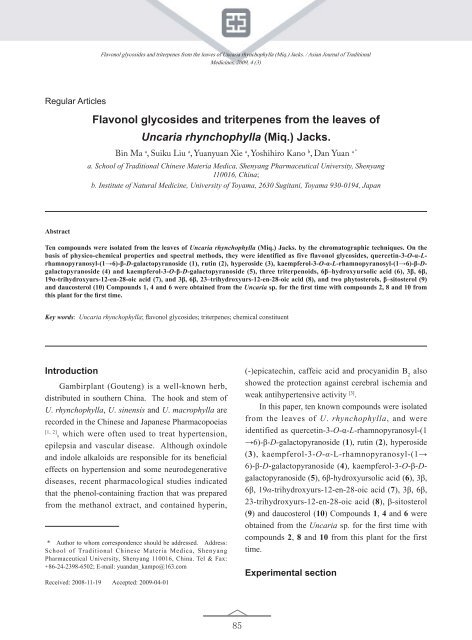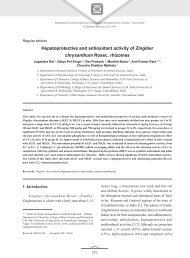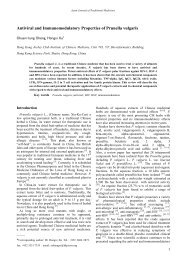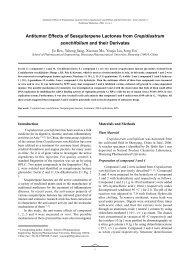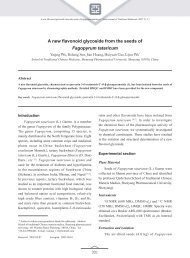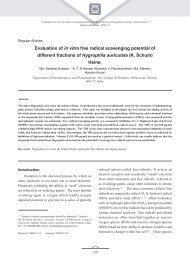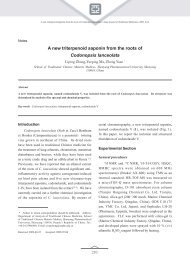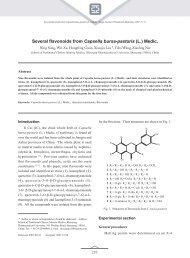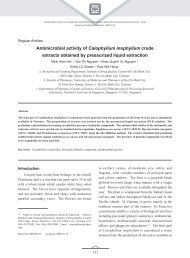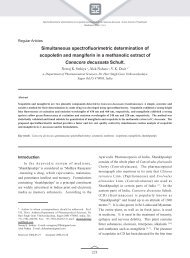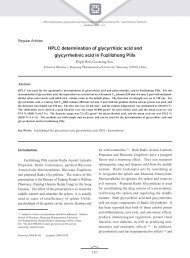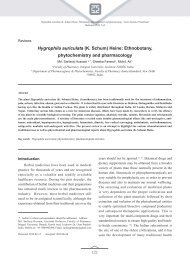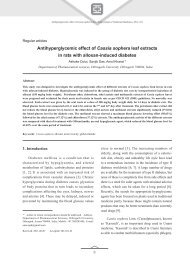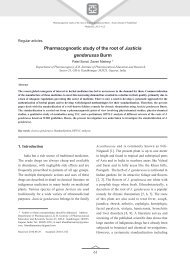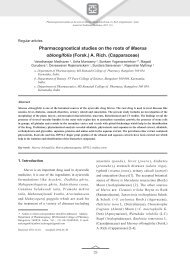Flavonol glycosides and triterpenes from the leaves of Uncaria ...
Flavonol glycosides and triterpenes from the leaves of Uncaria ...
Flavonol glycosides and triterpenes from the leaves of Uncaria ...
You also want an ePaper? Increase the reach of your titles
YUMPU automatically turns print PDFs into web optimized ePapers that Google loves.
<strong>Flavonol</strong> <strong>glycosides</strong> <strong>and</strong> <strong>triterpenes</strong> <strong>from</strong> <strong>the</strong> <strong>leaves</strong> <strong>of</strong> <strong>Uncaria</strong> rhynchophylla (Miq.) Jacks. / Asian Journal <strong>of</strong> TraditionalMedicines, 2009, 4 (3)Regular Articles<strong>Flavonol</strong> <strong>glycosides</strong> <strong>and</strong> <strong>triterpenes</strong> <strong>from</strong> <strong>the</strong> <strong>leaves</strong> <strong>of</strong><strong>Uncaria</strong> rhynchophylla (Miq.) Jacks.Bin Ma a , Suiku Liu a , Yuanyuan Xie a , Yoshihiro Kano b , Dan Yuan a *a. School <strong>of</strong> Traditional Chinese Materia Medica, Shenyang Pharmaceutical University, Shenyang110016, China;b. Institute <strong>of</strong> Natural Medicine, University <strong>of</strong> Toyama, 2630 Sugitani, Toyama 930-0194, JapanAbstractTen compounds were isolated <strong>from</strong> <strong>the</strong> <strong>leaves</strong> <strong>of</strong> <strong>Uncaria</strong> rhynchophylla (Miq.) Jacks. by <strong>the</strong> chromatographic techniques. On <strong>the</strong>basis <strong>of</strong> physico-chemical properties <strong>and</strong> spectral methods, <strong>the</strong>y were identified as five flavonol <strong>glycosides</strong>, quercetin-3-O-α-Lrhamnopyranosyl-(1→6)-β-D-galactopyranoside(1), rutin (2), hyperoside (3), kaempferol-3-O-α-L-rhamnopyranosyl-(1→6)-β-Dgalactopyranoside(4) <strong>and</strong> kaempferol-3-O-β-D-galactopyranoside (5), three triterpenoids, 6β–hydroxyursolic acid (6), 3β, 6β,19α-trihydroxyurs-12-en-28-oic acid (7), <strong>and</strong> 3β, 6β, 23–trihydroxyurs-12-en-28-oic acid (8), <strong>and</strong> two phytosterols, β–sitosterol (9)<strong>and</strong> daucosterol (10) Compounds 1, 4 <strong>and</strong> 6 were obtained <strong>from</strong> <strong>the</strong> <strong>Uncaria</strong> sp. for <strong>the</strong> first time with compounds 2, 8 <strong>and</strong> 10 <strong>from</strong>this plant for <strong>the</strong> first time.Key words: <strong>Uncaria</strong> rhynchophylla; flavonol <strong>glycosides</strong>; <strong>triterpenes</strong>; chemical constituentIntroductionGambirplant (Gouteng) is a well-known herb,distributed in sou<strong>the</strong>rn China. The hook <strong>and</strong> stem <strong>of</strong>U. rhynchophylla, U. sinensis <strong>and</strong> U. macrophylla arerecorded in <strong>the</strong> Chinese <strong>and</strong> Japanese Pharmacopoeias[1, 2], which were <strong>of</strong>ten used to treat hypertension,epilepsia <strong>and</strong> vascular disease. Although oxindole<strong>and</strong> indole alkaloids are responsible for its beneficialeffects on hypertension <strong>and</strong> some neurodegenerativediseases, recent pharmacological studies indicatedthat <strong>the</strong> phenol-containing fraction that was prepared<strong>from</strong> <strong>the</strong> methanol extract, <strong>and</strong> contained hyperin,* Author to whom correspondence should be addressed. Address:School <strong>of</strong> Traditional Chinese Materia Medica, ShenyangPharmaceutical University, Shenyang 110016, China. Tel & Fax:+86-24-2398-6502; E-mail: yu<strong>and</strong>an_kampo@163.comReceived: 2008-11-19 Accepted: 2009-04-01(-)epicatechin, caffeic acid <strong>and</strong> procyanidin B 2alsoshowed <strong>the</strong> protection against cerebral ischemia <strong>and</strong>weak antihypertensive activity [3] .In this paper, ten known compounds were isolated<strong>from</strong> <strong>the</strong> <strong>leaves</strong> <strong>of</strong> U. rhynchophylla, <strong>and</strong> wereidentified as quercetin-3-O-α-L-rhamnopyranosyl-(1→6)-β-D-galactopyranoside (1), rutin (2), hyperoside(3), kaempferol-3-O-α-L-rhamnopyranosyl-(1→6)-β-D-galactopyranoside (4), kaempferol-3-O-β-Dgalactopyranoside(5), 6β-hydroxyursolic acid (6), 3β,6β, 19α-trihydroxyurs-12-en-28-oic acid (7), 3β, 6β,23-trihydroxyurs-12-en-28-oic acid (8), β-sitosterol(9) <strong>and</strong> daucosterol (10) Compounds 1, 4 <strong>and</strong> 6 wereobtained <strong>from</strong> <strong>the</strong> <strong>Uncaria</strong> sp. for <strong>the</strong> first time withcompounds 2, 8 <strong>and</strong> 10 <strong>from</strong> this plant for <strong>the</strong> firsttime.Experimental section85
<strong>Flavonol</strong> <strong>glycosides</strong> <strong>and</strong> <strong>triterpenes</strong> <strong>from</strong> <strong>the</strong> <strong>leaves</strong> <strong>of</strong> <strong>Uncaria</strong> rhynchophylla (Miq.) Jacks. / Asian Journal <strong>of</strong> TraditionalMedicines, 2009, 4 (3)HO6758OH1O9 2 1'104O3OR 22' 3'R 1OH1 R 1 =-OH, R 2 =- β Gal 6 - α Rha2 R 1 =-OH, R 2 =- β Glc 6 - α Rha3 R 1 =-OH, R2 =- β Gal4 R 1 =-H, R 2 =- β Gal 6 - α Rha5 R 1 =-H, R 2 =- β Gal6'5'4'HO232414 5R 11125 2610236 R 1 =-H, R 2 =-H7 R 1 =-H, R 2 =-OH8 R 1 =-OH, R 2 =-H96OH128729R 21813 171427153020 211916COOH2822R 1 O231411199510H612H8721 2220131418H17H1615239 R 1 =-H10 R 1 =- β Glc282429252627Fig. 1. The structures <strong>of</strong> compounds 1–10Fig.1 The structures <strong>of</strong> compounds 1–10General experimental proceduresMelting points were determined on a Yanacomicro melting-point apparatus (uncorrected) (Japan).UV spectra was obtained using a Shimadzu UV-2201spectrophotometer. 1 H NMR <strong>and</strong> 13 C NMR spectrawere recorded on a Bruker ARX-300 spectrometerwith TMS as <strong>the</strong> internal st<strong>and</strong>ard. ESI-MS datawere acquired on a Shimadzu QP8000α HPLC-Mass spectrometer. Preparative HPLC was carriedout using a Shimadzu LC-8A solvent delivery pump<strong>and</strong> a Shimadzu SPD-10AVP detector. Silica-gel forchromatography was purchased <strong>from</strong> Qindao OceanChemicals Co., China, <strong>and</strong> polyamide was purchased<strong>from</strong> <strong>the</strong> Zhejiang Plastics Plant, China. SephadexLH-20 was purchased <strong>from</strong> GE Healthcare, Sweden.Plant materialsLeaves <strong>of</strong> U. rhynchophylla were collected inOctober 2005 in Fujian Province, China. A voucherspecimen is held in <strong>the</strong> Department <strong>of</strong> TraditionalChinese Medicines, Shenyang PharmaceuticalUniversity. Species identification was confirmed byPr<strong>of</strong>essor Zerong Jiang, Shenyang PharmaceuticalUniversity.Extraction <strong>and</strong> isolationThe air-dried <strong>leaves</strong> (2.5 kg) <strong>of</strong> U. rhynchophyllawere percolated with 75 % aqueous EtOH. The EtOHextract (670 g) was suspended in water <strong>and</strong> partitionedsuccessively with n-hexane (3 × 4 L), CHCl 3(3 × 4 L)<strong>and</strong> n-BuOH (3 × 4 L) to obtain <strong>the</strong> n-hexane extract(25 g), CHCl 3extract (55 g) <strong>and</strong> n-BuOH extract (250g), respectively. The n-BuOH extract was subjectedto silica-gel column chromatography (10 × 150 cm,200-300 mesh, Qindao Ocean Chemicals Co., China)involving elution with a CHCl 3-MeOH gradient.Several fractions (150 ml each) were collected,analyzed by TLC <strong>and</strong> grouped, accordingly.Three grams <strong>of</strong> <strong>the</strong> fraction eluted with CHCl 3-MeOH (20:1-10:1) (total 10 g) was subjected torepeated silica-gel column chromatography using aCHCl 3-MeOH solvent system <strong>and</strong> <strong>the</strong> eluates weregrouped on <strong>the</strong> basis <strong>of</strong> TLC analysis into six majorfractions (F1-F6). Fraction F2 was fur<strong>the</strong>r subjectedto ODS open column chromatography (3.0×30 cm, 50μm, YMC Co., Ltd, Japan) eluting with MeOH-H 2O(50:50-100:0). The fraction eluted with MeOH-H 2O(85:15) was purified a fur<strong>the</strong>r two times using ODSopen column chromatography to give compounds86
<strong>Flavonol</strong> <strong>glycosides</strong> <strong>and</strong> <strong>triterpenes</strong> <strong>from</strong> <strong>the</strong> <strong>leaves</strong> <strong>of</strong> <strong>Uncaria</strong> rhynchophylla (Miq.) Jacks. / Asian Journal <strong>of</strong> TraditionalMedicines, 2009, 4 (3)6 (40 mg) <strong>and</strong> 9 (60 mg). Fraction F4 was fur<strong>the</strong>rsubjected to ODS open column chromatographyeluting with MeOH-H 2O (50:50-100:0). The fractioneluted with MeOH-H 2O (75:25) was purified a fur<strong>the</strong>rtwo times using ODS open column chromatography togive compounds 7 (15 mg) <strong>and</strong> 8 (23 mg).Four grams <strong>of</strong> <strong>the</strong> fraction eluted with CHCl 3-MeOH (10:1-8:1) (total 13 g) was subjected to silicagelcolumn chromatography <strong>and</strong> eluted with a CHCl 3-MeOH gradient to obtain six fractions (F7-12).Fraction F8 (300 mg) was separated on a SephadexLH-20 (3.5×60 cm, GE Healthcare, Sweden) column,involving gradient elution with CHCl 3-MeOH(50:50) <strong>and</strong> was recrystallized in CHCl 3-MeOH toafford compound 10 (140 mg). Fraction F10 (450mg) was subjected to repeated polyamide columnchromatography (CHCl 3-MeOH; 20:1-1:1) , <strong>the</strong>nfur<strong>the</strong>r purified by preparative HPLC (Shim-packPRC-ODS, 2.0×30 cm, Shimadzu Co. Ltd, Japan)using MeOH-H 2O (55:45) as an eluent at a flow rate<strong>of</strong> 12 ml/min to afford compounds 3 (18 mg) <strong>and</strong> 5 (11mg).Three grams <strong>of</strong> <strong>the</strong> fraction eluted with CHCl 3-MeOH (8:1–5:1) (total 17 g) was subjected to silicagelcolumn chromatography <strong>and</strong> eluted with a CHCl 3-MeOH gradient to obtain nine fractions (F13-21).Fraction F17 (200 mg) was separated on a polyamidecolumn, involving gradient elution with CHCl 3-MeOH(50:50), <strong>the</strong>n fur<strong>the</strong>r purified by preparative HPLCusing MeOH-H 2O (40:60) as an eluent at a flow rate<strong>of</strong> 12 ml/min to afford Compounds 1 (19 mg), 2 (25mg) <strong>and</strong> 4 (20 mg).Results <strong>and</strong> discussionCompound 1Amorphous yellow powder, m.p. 193-195 °C. HCl-Mg reaction <strong>and</strong> Molish reaction: positive. UV (MeOH)λ max: 255, 358 nm. ESI-MS (m/z): 633 [M+Na] + , 649[M+K] + , 609 [M-H] - . Molecular formula: C 27H 30O 16.1H NMR (300 MHz, DMSO-d 6): δ H12.60 (1H, s,-OH-5), 7.66 (1H, dd, J = 8.5, 2.0 Hz, H-6’), 7.52 (1H,d, J=2.0 Hz, H-2’), 6.82 (1H, d, J=8.5 Hz, H-5’), 6.40(1H, d, J=1.9 Hz, H-8), 6.20 (1H, d, J=1.9 Hz, H-6),5.33 (1H, d, J=7.5 Hz, gal-1’’), 4.42 (1H, s, rha-1’’’),1.06 (3H, d, J=6.0 Hz, rha-6’’’). 13 C NMR (75 MHz,DMSO-d 6) see Table 1. All data were identical tothose <strong>of</strong> quercetin-3-O-α-L-rhamnopyranosyl-(1→6)-β-D-galactopyranoside [4] .Compound 2Amorphous yellow powder, m.p. 174-177 °C. HCl-Mg reaction <strong>and</strong> Molish reaction: positive. UV (MeOH)λ max: 257, 358 nm. ESI-MS (m/z): 633 [M+Na] + , 649[M+K] + , 609 [M-H] - . Molecular formula: C 27H 30O 16. 1 HNMR (300 MHz, DMSO-d 6): δ H12.60 (1H, s, -OH-5),10.83 (1H, s, -OH-7), 9.68 (1H, s, -OH-4’), 9.19 (1H,s, -OH-3’), 7.54 (2H, m, H-2’, 6’), 6.84 (1H, d, J = 8.8Hz, H-5’), 6.38 (1H, d, J = 2.0 Hz, H-8), 6.19 (1H, d,J = 2.0 Hz, H-6), 5.35(1H, d, J = 7.3 Hz, glc-1’’), 4.38(1H, s, rha-1’’’), 0.99 (3H, d, J = 6.3 Hz, rha-6’’’). 13 CNMR (75 MHz, DMSO-d 6) see Table 1. All data wereidentical to those <strong>of</strong> rutin [5] .Compound 3Amorphous yellow powder, m.p. 221-224 °C. HCl-Mg reaction <strong>and</strong> Molish reaction: positive. UV (MeOH)λ max: 256, 354 nm. ESI-MS (m/z): 487 [M+Na] + , 503[M+K] + , 463 [M-H] - . Molecular formula: C 21H 20O 12.1H NMR (300 MHz, DMSO-d 6): δ H12.6 (1H, s,-OH-5), 7.67 (1H, dd, J = 8.5, 1.2 Hz, H-6’), 7.53 (1H,d, J = 1.6 Hz, H-2’), 6.82 (1H, d, J = 8.5 Hz, H-5’),6.41 (1H, d, J = 1.2 Hz, H-8), 6.21 (1H, d, J = 1.2 Hz,H-6), 5.38 (1H, d, J = 7.7 Hz, gal-1’’). 13 C NMR (75MHz, DMSO-d 6) see Table 1. All data were identicalto those <strong>of</strong> hyperoside [6] .Compound 4Amorphous yellow powder, m.p. 187-190 °C. HCl-Mg reaction <strong>and</strong> Molish reaction: positive. UV (MeOH)λ max: 265, 354 nm. ESI-MS (m/z): 617 [M+Na] + , 633[M+K] + , 593 [M-H] - . Molecular formula: C 27H 30O 15.1H NMR (300 MHz, DMSO-d 6): δ H12.60 (1H, s,-OH-5), 8.05 (2H, d, J = 8.6 Hz, H-2’, 6’), 6.8687
<strong>Flavonol</strong> <strong>glycosides</strong> <strong>and</strong> <strong>triterpenes</strong> <strong>from</strong> <strong>the</strong> <strong>leaves</strong> <strong>of</strong> <strong>Uncaria</strong> rhynchophylla (Miq.) Jacks. / Asian Journal <strong>of</strong> TraditionalMedicines, 2009, 4 (3)(2H, d, J = 8.6 Hz, H-3’, 5’), 6.41 (1H, s, H-8), 6.19(1H, s, H-6), 5.32 (1H, d, J = 7.6 Hz, gal-1’’), 4.40(1H, s, rha-1’’’), 1.06 (3H, d, J = 6.0 Hz, rha-6’’’). 13 C NMR (75 MHz, DMSO-d 6) see Table 1. Alldata were identical to those <strong>of</strong> kaempferol-3-O-α-Lrhamnopyranosyl-(1→6)-β-D-galactopyranoside[7] .Compound 5Amorphous yellow powder, m.p. 238-240 °C. HCl-Mg reaction <strong>and</strong> Molish reaction: positive. UV (MeOH)λ max: 266, 353 nm. ESI-MS (m/z): 471 [M+Na] + , 487[M+K] + , 447 [M-H] - . Molecular formula: C 21H 20O 11.1H NMR (300 MHz, DMSO-d 6): δ H12.60 (1H, s,-OH-5), 10.31 (1H, s, -OH-7), 8.07 (2H, d, J = 8.7 Hz,H-2’, 6’), 6.86 (2H, d, J = 8.7 Hz, H-3’, 5’), 6.43 (1H,s, H-8), 6.21 (1H, s, H-6), 5.41 (1H, d, J = 7.5 Hz,gal-1’’). 13 C NMR (75 MHz, DMSO-d 6) see Table 1.All data were identical to those <strong>of</strong> kaempferol-3-O-β-D-galactopyranoside [8] .Compound 6Table 1. 13 C NMR (75 MHz) data <strong>of</strong> compounds 1–5 (DMSO-d 6)Position 1 2 3 4 52 156.4 156.5 156.4 156.6 156.43 133.6 133.4 133.5 133.4 133.34 177.5 177.5 177.5 177.5 177.65 161.3 161.3 161.3 161.3 161.36 98.8 98.8 98.7 99.0 98.87 164.3 164.2 164.2 164.0 164.38 93.7 93.7 93.6 93.9 93.89 156.4 156.7 156.3 156.6 156.410 104.0 104.0 104.0 103.8 104.01' 121.1 121.3 121.1 120.9 121.02' 115.3 115.3 115.2 131.0 131.13' 144.9 144.8 144.9 115.1 115.24' 148.6 148.5 148.5 160.1 160.15' 116.0 116.3 116.0 115.1 115.26' 122.0 121.7 122.0 131.0 131.11'' 102.1 101.3 101.8 102.2 101.72'' 71.2 74.2 71.3 71.2 71.33'' 73.1 76.5 73.2 73.1 73.24'' 68.4 70.1 68.0 68.1 68.05'' 73.6 76.5 75.9 73.6 75.96'' 65.2 67.1 60.2 65.4 60.31''' 100.1 100.8 100.12''' 70.5 70.5 70.53''' 70.7 70.6 70.74''' 72.0 71.9 72.05''' 68.1 68.3 68.46''' 18.0 17.8 18.088
<strong>Flavonol</strong> <strong>glycosides</strong> <strong>and</strong> <strong>triterpenes</strong> <strong>from</strong> <strong>the</strong> <strong>leaves</strong> <strong>of</strong> <strong>Uncaria</strong> rhynchophylla (Miq.) Jacks. / Asian Journal <strong>of</strong> TraditionalMedicines, 2009, 4 (3)Table 2. 13 C NMR (75 MHz) data <strong>of</strong> compounds 6-10Position 6 a 7 a 8 a 9 b 10 a1 39.4 41.7 39.7 37.2 37.02 24.1 26.5 24.8 31.6 29.83 78.6 78.8 71.8 71.8 78.14 39.3 39.8 42.6 42.3 38.95 56.4 56.5 47.7 140.7 140.46 67.6 67.8 66.1 121.7 121.57 33.3 41.3 39.9 31.9 31.68 41.6 40.5 38.0 31.9 31.79 48.1 48.4 47.2 50.1 50.010 37.1 37.2 36.1 36.5 36.511 23.7 24.1 22.3 21.1 20.812 126.1 128.5 124.7 28.3 28.113 138.6 139.4 137.2 42.3 42.014 43.0 42.7 41.6 56.8 56.415 31.0 29.3 27.3 24.3 24.116 25.0 28.4 26.6 39.8 39.517 48.6 48.4 46.7 56.0 55.818 53.6 54.7 52.2 11.9 11.519 39.6 72.8 38.1 19.1 18.820 41.2 42.4 40.7 36.1 35.921 31.1 27.0 29.7 18.8 18.622 37.5 38.6 35.5 33.9 33.723 28.7 28.6 65.7 26.0 25.924 18.8 18.1 17.4 45.8 45.625 17.2 17.2 13.3 29.1 29.026 17.6 18.3 17.2 19.4 19.027 23.8 24.8 23.6 19.8 19.528 179.9 180.7 178.5 23.0 22.929 18.1 27.2 16.2 12.0 11.730 21.4 16.8 20.0Glc-1 102.12 74.93 78.24 71.25 77.66 62.4a, bMeasured separately in C 5D 5N <strong>and</strong> CDCl 389
<strong>Flavonol</strong> <strong>glycosides</strong> <strong>and</strong> <strong>triterpenes</strong> <strong>from</strong> <strong>the</strong> <strong>leaves</strong> <strong>of</strong> <strong>Uncaria</strong> rhynchophylla (Miq.) Jacks. / Asian Journal <strong>of</strong> TraditionalMedicines, 2009, 4 (3)Amorphous colorless powder. Liebermann-Burchard reaction: positive. ESI-MS (m/z): 495[M+Na] + , 471 [M-H] - . Molecular formula: C 30H 48O 4.1H NMR (300 MHz, C 5D 5N): δ H0.95 (3H, d, J = 6.3Hz, H-29), 1.00 (3H, d, J = 6.0 Hz, H-30), 1.25 (3H,s, H-23), 1.43 (3H, s, H-26), 1.61 (3H, s, H-24), 1.62(3H, s, H-25), 1.72 (3H, s, H-27), 3.11 (1H, m, 4.2 Hz,H-3), 4.86 (1H, brs, H-6), 5.44 (1H, brs, H-12). 13 CNMR (75 MHz, C 5D 5N) see Table 2. All data wereidentical to those <strong>of</strong> 6β-hydroxyursolic acid [9] .Compound 7Amorphous colorless powder. Liebermann-Burchard reaction: positive. ESI-MS (m/z): 511[M+Na] + , 487 [M-H] - . Molecular formula: C 30H 48O 5.1H NMR (300 MHz, C 5D 5N): δ H1.12 (3H, d, J = 6.3Hz, H-30), 1.42 (3H, s, H-23), 1.48 (3H, s, H-26), 1.63(3H, s, H-29), 1.69 (3H, s, H-24), 1.73 (3H, s, H-25),1.77 (3H, s, H-27), 2.51 (1H, m, H-16α), 3.46 (1H, dd,J = 11.4, 4.1 Hz, H-3), 5.44 (1H, brs, H-12). 13 C NMR(75 MHz, C 5D 5N) see Table 2. All data were identicalto those <strong>of</strong> 3β, 6β, 19α-trihydroxyurs-12-en-28-oicacid [10] .Compound 8Amorphous colorless powder. Liebermann-Burchard reaction: positive. ESI-MS (m/z): 511[M+Na] + , 487 [M-H] - . Molecular formula: C 30H 48O 5.1H NMR (300 MHz, C 5D 5N): δ H0.92 (3H, d, J = 4.2Hz, H-30), 1.01 (3H, d, J = 7.5 Hz, H-29), 1.20 (3H,s, H-26), 1.64 (3H, s, H-24), 1.67 (3H, s, H-27), 1.72(3H, s, H-25), 4.27 (1H, dd, J = 11.4, 4.1 Hz, H-3),4.42, 4.00 (2H, each 1H, d, J = 10.3 Hz, H-23), 5.45(1H, brs, H-12). 13 C NMR (75 MHz, C 5D 5N) seeTable 2. All data were identical to those <strong>of</strong> 3β, 6β,23-trihydroxyurs-12-en-28-oic acid [10, 11] .Compound 9Amorphous colorless powder. Liebermann-Burchard reaction: positive. Molecular formula:C 29H 50O. 1 H NMR (300 MHz, CDCl 3): δ H0.68 (3H,s, H-18), 0.80-0.93 (15H, each 3H, m), 3.53 (1H, m,H-3), 5.35 (1H, m, H-6). 13 C NMR (75 MHz, CDCl 3)see Table 2. All data were identical to those <strong>of</strong>β-sitosterol [12] .Compound 10Amorphous colorless powder. Liebermann-Burchard reaction <strong>and</strong> Molish reaction: positive.Molecular formula: C 35H 60O 6. 1 H NMR (300 MHz,C 5D 5N): δ H0.65 (3H, s, H-18), 0.84-1.01 (15H, each3H, m), 5.06 (1H, d, J = 7.8 Hz, glc-1′), 5.35 (1H, brs,H-6). 13 C NMR (75 MHz, C 5D 5N) see Table 2. Alldata were identical to those <strong>of</strong> daucosterol [9] .AcknowledgementThis study was supported by research funds<strong>from</strong> <strong>the</strong> 2005 Scientific Technology Plan Project <strong>of</strong>Liaoning Province Government, China.References[1] The State Pharmacopoeia Committee <strong>of</strong> China.Pharmacopoeia <strong>of</strong> <strong>the</strong> People’s Republic <strong>of</strong> China, 2005Edition, Vol. 1. Beijing: Chemical Industry Press, 2005,180.[2] Japanese Pharmacopoeia Editorial Committee. TheJapanese Pharmacopoeia, 15th Ed. Tokyo: HirohawaPress, 2006, 462-5.[3] Zhao Q, Watanabe Y, Sakakibara I, Zhang SH, MurakamiT, Higashida M, Matsumoto S. Antihypertensive activity<strong>and</strong> protection against cerebral ischemia <strong>of</strong> phenolcontainingfraction <strong>of</strong> <strong>Uncaria</strong> hooks <strong>and</strong> its components.Medical <strong>and</strong> Pharmaceutical Society for WAKAN-YAKU,2002, 8, Suppl 152.[4] Liang QL, Ding LS. Chemical study on <strong>the</strong> Leaves <strong>of</strong>Raisin Tree (Hovenia acerba) (I). Zhongcaoyao, 1996,27(10): 581-3.[5] Jiang SJ, Zhu B, Zhang NP, Lin RC. Chemical study on <strong>the</strong>Galeobdolon chinense. Journal <strong>of</strong> China PharmaceuticalUniversity, 2002, 33(9): 487-8.[6] Zhang W, Zhao DB, Li MJ, Liu XH, Wang HQ. Studies onflavonoid constituents <strong>from</strong> herbs <strong>of</strong> Artemisia ordosicaII. China Journal <strong>of</strong> Chinese Materia Medica, 2006,31(23): 1959-61.[7] Brasseur T, Angenot L. <strong>Flavonol</strong> <strong>glycosides</strong> <strong>from</strong> <strong>leaves</strong> <strong>of</strong>Strychnos variabilis. Phytochemistry, 1986, 25(2): 563-4.[8] Huang KY, Zhang DS, Gao HY, Wu LJ. Chemicalconstituents <strong>of</strong> Dioscorea bulbifera L. Journal <strong>of</strong>90
<strong>Flavonol</strong> <strong>glycosides</strong> <strong>and</strong> <strong>triterpenes</strong> <strong>from</strong> <strong>the</strong> <strong>leaves</strong> <strong>of</strong> <strong>Uncaria</strong> rhynchophylla (Miq.) Jacks. / Asian Journal <strong>of</strong> TraditionalMedicines, 2009, 4 (3)Shengyang Pharmaceutical University, 2007, 24(3):145-7.[ 9 ] S a k a k i b a r a J , K a i y a T, F u k u d a H , O h k i T.6β-hydroxyursolic acid <strong>and</strong> o<strong>the</strong>r triterpenoids <strong>of</strong>Enkianthus cernuus. phytochemistry, 1983, 22(11):2553-5.[10] Yang J, Song CQ, Hu ZB. Studies on constituents in<strong>Uncaria</strong> macrophylla Wall. China Journal <strong>of</strong> ChineseMateria Medica, 2000, 25(8): 484-5.[11] Kuroda M, Mimaki Y, Harada H, Sakagami H, Sashida Y.Five New triterpene <strong>glycosides</strong> <strong>from</strong> Centella asiatica.Nat Med, 2001, 55(3): 134-8.[12] Koizumi N, Fujimoto Y, Takeshita T, Ikekawa N.Carbon-13 nuclear magnetic resonance <strong>of</strong> 24-substitutedsteroids. Chem Pharm Bull, 1979, 27(1): 38-42.91


